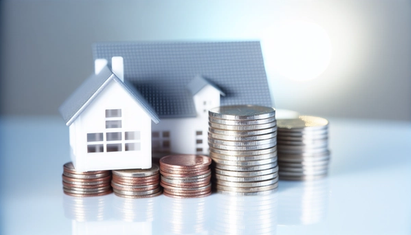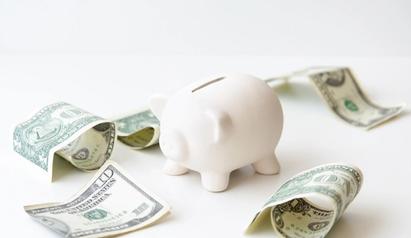Mortgage Rates Explained: What Affects Your Rate
Written by:
Lauren Hargrave
Lauren Hargrave
Personal Finance Writer
Lauren Hargrave is a writer from San Diego who focuses on technology, finance, and healthcare. She worked in finance for seven years before pivoting to a career in writing, and now, instead of putting numbers into spreadsheets, she writes about them instead.
See full bio
Fact Checked by:
Mike Tassone
Mike is a Co-Founder and Chief Operating Officer of Own Up. He has expertise in all areas of residential lending, having led operations for a top 40 lender in the United States.
See full bio

Wherever you are in the home buying process, you’ve probably read, heard, or just know that you want a low mortgage rate. It may even seem simple: The lower your rate, the less expensive your loan is. And while at its core, that statement is true, there are many things that can affect the interest rate you pay on your mortgage – only a portion of which are in your control.
With that in mind, buying the home you want might not be as simple as getting as many quotes from as many mortgage lenders as possible to find the lowest rate. There are definitely other factors that come into play; understanding how those factors apply to your particular situation is the best way to prepare for the mortgage application process. So let’s get started.
What is a Mortgage Rate?
A mortgage rate is the interest rate you pay on your home mortgage. It is the percentage the lender charges for every dollar you borrow and directly affects your monthly mortgage payment and the cost of your home.
For example, if you arrange for a 30-year, 360-payment, fixed-rate loan of $500,000 with a 6.5% interest rate, your monthly principal and interest payment will be $3,160. The same loan with a 7.5% interest rate would cost $3,496 per month.
There are other costs that may influence the actual total cost of your monthly payment, such as private mortgage insurance (PMI), homeowner association fees, and property taxes, but the above example gives you an idea of how your mortgage rate directly impacts your monthly payment and its ability to fit within your monthly budget. If you’re looking for a specific loan amount and you’re curious what your monthly payment could look like, use this simple mortgage calculator to play with the numbers.
The Two Types of Mortgage Rates
In the example above, you might have noticed the term “fixed rate.” That's because a fixed rate is one type of mortgage rate. The other type of mortgage rate is an adjustable rate.
Fixed-Rate Mortgage
A fixed-rate mortgage has the same interest rate for the entire loan term. If you’re applying for a fixed-rate loan, you’ll receive a Loan Estimate from your mortgage lender that includes an estimated interest rate. This is the current rate and what your interest rate would be if you “locked” your interest rate that day.
Locking your interest rate means you’ve completed the necessary process with your mortgage lender to guarantee your interest rate won’t change for a certain period of time. The process could include submitting the required documentation, signing paperwork, and perhaps paying a fee.
Lenders typically only lock an interest rate for a specified period of time, and if you don’t close the loan within that time frame, the lender can reprice your loan (meaning you could end up with a higher interest rate than you originally thought). You might be able to buy a rate lock extension, but this option is often cost-prohibitive, so if you do lock your interest rate, it’s important to ensure you have enough time to close the loan before it expires.
There are many factors that influence how a loan’s interest rate is priced, so if you don’t lock your interest rate, it can change between the time the Loan Estimate is issued and the time you either lock your rate or close on your loan (whichever comes first).
Adjustable-Rate Mortgages (ARMs)
ARMs are also known as variable rate mortgages and are typically structured as a hybrid loan. This means there is a fixed-rate period at the beginning of the loan term, then the interest rate begins to float – or adjust – after that.
The interest rates for ARMs are typically capped at a ceiling interest rate. That means regardless of what is happening in the market, that ceiling interest rate is the highest possible interest rate you can pay. Some lenders might allow you to purchase a lower interest rate cap for a fee.
Monthly mortgage payments on an ARM can look three ways:
1. Hybrid
If your ARM is structured this way, your rate will be fixed for a period of time and adjust after that. These terms are typically represented by two numbers, such as 5/25. The first number tells you how long the interest rate will be locked, and the second tells you how long it will be adjustable. In the case of 5/25, the initial interest rate is locked for the first five years and is adjustable for the 25 years after that. Usually this type of loan will be paid off in-full by the end of the loan term.
2. Interest-only
In this scenario, the borrower only pays for the interest charge each month. The interest-only payments last for a specified period of time, then the monthly payments start to include both the principal and interest. This type of ARM usually results in a balloon payment at the end of the loan term. A balloon payment is a mortgage payment that is considerably larger than the traditional loan payment and can be tens of thousands of dollars, depending how long the interest-only period payments lasted.
3. Payment-option
Some ARM lenders allow borrowers to choose the payment option that works for them that month. These options include: interest-only payment, principal and interest payment, or paying a minimum amount that might not cover the interest. These types of loans can result in a balloon payment at the end of the loan term if borrowers don’t choose to pay the monthly principal each month.
Which Factors Affect My Mortgage Rate?
There area variety of factors across several categories that can affect your mortgage rate.
8 Market Factors That Impact Your Mortgage Rate
Market or economic factors largely affect the index on which your mortgage rate is based, but can also affect the rate you’re charged. Market factors may include:
1. The Bond Market
The bond market sells bundles of home mortgages in a financial vehicle called mortgage-backed securities. When the price of mortgage bonds increases, interest rates on mortgages tend to drop. The inverse is also true.
2. The Prime Rate
This is the cited interest rate that lenders are willing to offer to their best-rated or prime borrowers. It’s determined by the United States’ largest banks and adjusts periodically depending on market forces (including actions by the Federal Reserve). Typically the Prime Rate is equal to the Fed Funds Rate + 3.00%.
While the Prime Rate index is not typically used in traditional fixed rate-mortgages, it is a very common rate index for Home Equity Lines of Credit (HELOCs). Creditworthy consumers may be eligible for a Prime Rate mortgage (plus or minus a spread, which is the amount the lender adds to the index to determine what they will make on the loan). In addition to being the index for HELOCs, the Prime Rate is also used in other consumer lending products like credit cards, personal loans, and student loans. As banks raise the Prime Rate, mortgage rates increase, as well.
3. The Fed Funds Rate
Contrary to what you might have heard, the Federal Reserve (the Fed) doesn’t set interest rates. What they do is raise or lower the price at which banks can borrow money. This affects the supply of money in the economy since the more expensive it is for banks to borrow money, the more expensive it is for consumers to borrow money from the bank. The Prime Rate usually follows the fed target rate (which is also referred to as the fed funds rate). Thus, as the Fed raises its target rate, interest rates usually follow suit.
4. The SOFR
This is what it costs banks to borrow money from each other in a short-term, overnight loan. If you’re applying for an ARM, your lender will typically price your interest rate based on the SOFR.
Since ARMs are directly priced over this index, an increase or decrease in the SOFR results in a corresponding increase or decrease in ARM rates.
5. Inflation
One of the issues the Fed focuses on is keeping inflation low enough so that it doesn’t damage the economy. One of the levers the Fed has for doing this is raising its target interest rate.
6. Housing Prices
The correlation between the housing market and interest rates can be nuanced. It’s true, and perhaps obvious, that quickly rising interest rates should have a depressive effect on housing prices. However, the historical correlation has actually been seen in reverse. Housing prices tend to increase in an inflationary environment, and in an inflationary environment, the Fed is likely going to raise their target rate, which can result in higher mortgage rates.
7. The Unemployment Rate
A low unemployment rate can fuel inflation and an increase in home prices, which can prompt the Fed to raise its rates, and also banks to charge each other higher SOFRs and consumers higher Prime rates.
8. Other Market Factors
There are other market factors that may impact your mortgage rate, including the stock market, oil prices, and more. However, the previously mentioned factors will have the biggest impact on the indices on which your overall interest rate is priced.
Borrower Factors
The spread your mortgage lender charges will be based, in part, on their assessment of how likely you are to pay them back. The less likely they think you are to default on your loan, the “stronger” the borrower they think you are. The stronger the borrower, the lower the spread they’ll charge.
Your lender will use these three personal details about you to try to determine your strength as a borrower:
1. Your Credit Score
Your credit score is a number that is monitored by three different credit agencies and is the result of your credit history. Credit card companies, utilities, etc. report your payment history to the credit bureaus and the credit bureaus will increase or decrease your score accordingly. Other factors that affect your credit score are the length of your credit history, the number of “hard inquiries” the credit bureau has received for your credit report (the more hard inquiries they receive in a short period of time, the lower your score is likely to be), and your credit utilization rate. Your credit utilization rate is how much of your available credit you’re using. (You want this number to be low.)
2. Your Income
Your income will influence both your loan amount and the interest rate you’re charged on said loan. Lenders want to see that you’re bringing home enough income each month to comfortably cover the mortgage payment.
3. Down Payment Percentage
Typically, lenders offer lower interest rates to borrowers that put down a larger down payment. That’s because they believe having more equity in your home makes you a less risky borrower.
Home Factors
The interest rate you pay on your home mortgage can change depending on where your home is located. The state and county in which your home is located can have an effect on your interest rate, as well as if it’s located in an urban or rural setting.
Loan Factors
Your loan amount, loan term, and the type of interest rate you’re seeking (i.e. fixed vs. ARM), and the type of loan you’re seeking (e.g. conventional loan vs. FHA) all affect your interest rate. A large loan amount can cause your lender to increase your interest rate, while a shorter mortgage term (e.g. a 15-year mortgage vs. a 30-year mortgage) may cause your lender to lower your rate.
As we addressed above, the type of interest rate you’re seeking will determine the index on which your loan is priced, which will affect your interest rate. With regards to the loan type, some loan types will be a better fit and more affordable for your specific situation. See our post on mortgage types to dive into this topic further.
Some lenders offer borrowers the option to pay a fee upfront for a lower interest rate on their loan. If your lender offers this, make sure you run the numbers to make sure that it will make sense for your specific financial situation before you agree to it.
How Do You Know if You Have a “Good” Mortgage Rate
The term “good mortgage rate” can be misleading because “good” is a relative term. Interest rates are priced on a case-by-case basis and are affected by many factors that are specific to the borrower and the home. So, it’s hard to compare your interest rate with your buddy’s rate to tell if you have a “good” one.
The best way to know if you have the best mortgage rate for your specific situation is to educate yourself on current rates and the mortgage market in general, and the best type of mortgage and interest rate for you. Once you have done this, try to get as many Loan Estimates as possible and compare the terms. If you’re not seeing interest rates quoted as low as you were hoping, ask the mortgage lenders how they priced your loan and ask about how you might receive a lower rate.
Buying a home can be an emotional and stressful process, but once you understand how things are priced, and what you do have control over (and what you don’t), you can take a rational approach and find the best home and mortgage lender for you.


